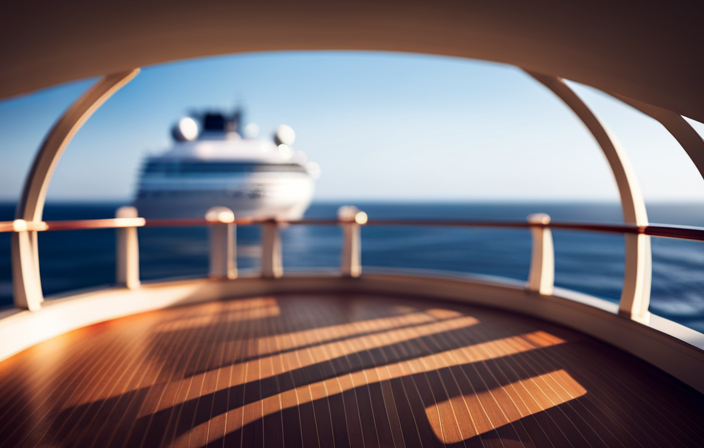Have you ever pondered why cruise ships appear to lack a thirteenth deck? This intriguing fact has sparked the interest of numerous explorers. Intrigued by the impact of superstitions on architectural decisions, I set out on a journey to discover the secrets behind this peculiar occurrence.
What I discovered was a fascinating blend of history, culture, and psychology that sheds light on why cruise ships choose to skip this seemingly innocent number.
Throughout history, the number 13 has been plagued by superstitions, often associated with bad luck and unfortunate events. This belief has seeped into various aspects of our lives, including the design of cruise ships. By understanding the origins of this superstition and its impact on passenger perception, we can unravel the reasons behind the absence of a deck 13.
Join me as we delve into the intriguing world of cruise ship design, uncover the psychological impact of skipping deck 13, and debunk the myths and misconceptions surrounding this peculiar phenomenon. Prepare to be enlightened and entertained as we explore the hidden depths of why there is no deck 13 on cruise ships.
Key Takeaways
- Superstitions and cultural beliefs play a significant role in cruise ship design, particularly in the omission of Deck 13.
- Cruise ship companies prioritize passenger comfort and satisfaction by accommodating superstitious beliefs and avoiding potential offense or alienation.
- Design adaptations, such as rearranging or renaming decks, are made to create an inclusive and superstitious-free environment for diverse passengers.
- The absence of Deck 13 is a conscious effort to understand and respect the psychology of superstition and cultural nuances, ensuring a pleasant and enjoyable experience for all.
The Origins of Superstition Surrounding the Number 13
The origins of the superstition surrounding the number 13 can be traced back to ancient times. The fear of the number 13, known as triskaidekaphobia, has deep cultural roots and is seen in various civilizations around the world.
It is believed that the fear originated in ancient religions and mythologies, where the number 12 was considered sacred and complete, representing harmony and balance. The number 13, being one more than 12, was seen as disruptive and unlucky.
This superstition has been passed down through generations, with cultural variations adding to its complexity. In Norse mythology, for example, the mischievous god Loki was the 13th guest at a dinner party, leading to chaos and the ultimate demise of one of the gods.
These historical examples of the number 13 being considered unlucky provide insight into the origins of this enduring superstition.
Historical Examples of the Number 13 Being Considered Unlucky
Throughout history, countless tales have woven a web of superstition around the number 13, captivating minds with its mysterious and foreboding nature.
The origins of this superstition can be traced back to various historical examples where the number 13 was considered unlucky. One such example is the Last Supper, where Judas Iscariot, the betrayer of Jesus, was the 13th person to sit at the table.
Additionally, the Knights Templar, a medieval Christian military order, were arrested on Friday the 13th, leading to their downfall.
These events, along with others, have had a psychological impact on people, ingraining a fear of the number 13 in their minds.
This fear and superstition have influenced various aspects of society, including cruise ship design. [Transition to the subsequent section about the influence of superstitions on cruise ship design].
The Influence of Superstitions on Cruise Ship Design
Immerse yourself in the world of cruise ship design and witness how superstitions have shaped the very structure and layout of these majestic vessels. The influence of superstitions on cruise ship design is a fascinating subject. It delves into the psychological implications and architectural alternatives that have emerged due to these beliefs.
One notable example is the absence of a deck 13 on many cruise ships. While it may seem like a simple omission, this decision stems from the long-standing superstition that the number 13 is unlucky. By skipping deck 13, cruise ship designers aim to alleviate any potential anxiety or fear that passengers may have. This attention to detail shows the thoughtfulness and consideration that goes into creating a comfortable and enjoyable experience for all on board.
Moving forward, let’s explore the psychological impact of skipping deck 13 on passengers without missing a beat.
The Psychological Impact of Skipping Deck 13 on Passengers
By skipping the 13th deck, cruise ship designers have created an intriguing psychological effect on passengers. This design choice has a profound impact on the passenger experience, shaping their perception of the cruise and enhancing their overall enjoyment. Here are four ways in which the psychological effects of skipping deck 13 influence passengers:
-
Sense of relief: Passengers experience a subtle sense of relief knowing that they are not on a supposedly unlucky deck.
-
Enhanced positive mindset: The absence of the 13th deck creates a positive atmosphere, allowing passengers to focus on the exciting and enjoyable aspects of their journey.
-
Increased satisfaction: Passengers may attribute any positive experiences or good luck they encounter on the cruise to the absence of deck 13, leading to a heightened sense of satisfaction.
-
Reinforcement of superstitions: The omission of deck 13 reinforces the belief in superstitions for some passengers, adding to the mystique and allure of the cruise experience.
As we explore the impact of culture and beliefs on cruise ship design, we can understand how these factors shape the decision to skip deck 13, further influencing the passenger experience.
The Impact of Culture and Beliefs on Cruise Ship Design
The cultural and belief systems of passengers greatly influence the design choices made for cruise ships, shaping the overall experience and enhancing their enjoyment. One example of this is the influence of numerology on cruise ship design. Numerology is the belief in the mystical significance of numbers, and many cultures consider the number 13 to be unlucky. This cultural taboo surrounding the number 13 has led to the practical decision of skipping deck 13 on cruise ships. Instead of having a deck labeled as 13, cruise ships often go from deck 12 directly to deck 14. This design choice is made to avoid any potential discomfort or anxiety that passengers may feel due to their cultural beliefs about the number 13. Moving forward, let’s explore the practical reasons for skipping deck 13 on cruise ships.
Practical Reasons for Skipping Deck 13 on Cruise Ships
One practical reason for avoiding the designation of the 13th deck on cruise ships is the cultural taboo surrounding this number. Many people believe that the number 13 is unlucky, which can have psychological implications for guests on board.
To ensure customer satisfaction and perception, cruise ship designers often skip the 13th deck to avoid any potential negative associations.
In addition to cultural beliefs, there are also engineering limitations that may contribute to the absence of a 13th deck. Cruise ships are carefully designed to maximize space and efficiency, and sometimes skipping a deck number allows for better alignment of amenities and facilities.
By considering both cultural beliefs and engineering limitations, cruise ship designers aim to create an enjoyable and comfortable experience for all passengers.
Moving on to the next section, the role of customer satisfaction and perception in cruise ship design becomes evident.
The Role of Customer Satisfaction and Perception in Cruise Ship Design
Imagine yourself on a luxurious floating paradise, where every aspect of the design is meticulously crafted to ensure your utmost satisfaction and create an unforgettable experience. Cruise ship designers understand the importance of customer feedback and continuously strive to make design improvements based on their input. Here are three ways they incorporate customer satisfaction and perception into the ship’s design:
-
Layout and Flow: Designers carefully consider the flow of passengers throughout the ship, ensuring easy navigation and minimizing potential congestion points.
-
Amenities and Entertainment: They focus on providing a diverse range of amenities and entertainment options, catering to different preferences and ensuring there is something for everyone.
-
Comfort and Aesthetics: Designers pay attention to the smallest details, from comfortable seating areas to visually appealing decor, creating an ambiance that enhances the overall experience.
Transitioning into the subsequent section about alternative designations for deck 13 on cruise ships, it’s interesting to explore how superstitious beliefs have influenced the industry.
Alternative Designations for Deck 13 on Cruise Ships
As we explored earlier, the role of customer satisfaction and perception plays a crucial part in cruise ship design. Continuing this discussion, let’s now delve into alternative designations for Deck 13 on cruise ships.
It is a well-known fact that many cruise ships skip the number 13 when it comes to naming their decks. Instead, they opt for alternative names such as ‘Deck 12A’ or ‘Sun Deck.’
This practice stems from the cultural significance attached to the number 13, which is often associated with bad luck in Western superstitions. By avoiding the number 13, cruise ship companies aim to cater to passengers who may feel uncomfortable or superstitious about staying on a deck with this number.
This attention to detail in design showcases the industry’s commitment to ensuring a positive and enjoyable experience for all passengers.
Now, let’s explore the cultural variations in superstitions and cruise ship design.
Cultural Variations in Superstitions and Cruise Ship Design
Explore the diverse cultural superstitions around the world and witness how these beliefs influence the intricate design choices made by cruise ship companies.
-
Numerology: Numerology plays a significant role in shaping cruise ship designs around the world. In some cultures, the number 13 is considered unlucky, so cruise ship companies avoid having a Deck 13 altogether. They often skip from Deck 12 to Deck 14 to appease superstitious passengers.
-
Cultural Variations: Different cultures have their own unique beliefs and superstitions. While Western cultures may view the number 13 as unlucky, other cultures may have different unlucky numbers. Cruise ship companies take these cultural variations into account to cater to a diverse range of passengers.
-
Design Adaptations: To accommodate the influence of numerology and cultural superstitions, cruise ship companies may modify their design plans. They may rearrange decks or rename them to avoid the number 13, ensuring a more comfortable and superstitious-free experience for their guests.
-
Passenger Comfort: By considering cultural variations in ship design, cruise ship companies aim to create a comfortable and enjoyable experience for their passengers. Understanding and respecting these superstitions allows companies to provide a sense of security and peace of mind to their guests.
With an understanding of the influence of numerology and cultural variations in ship design, we can now move on to debunking myths and misconceptions about the missing deck 13.
Debunking Myths and Misconceptions about the Missing Deck 13
Despite common misconceptions, the absence of Deck 13 on cruise ships is not a deliberate attempt to exclude superstitious passengers, but rather a design adaptation that respects cultural beliefs and ensures a comfortable experience for all guests. The psychology of superstition plays a significant role in this decision, as many people associate the number 13 with bad luck. By omitting Deck 13, cruise ship designers acknowledge and accommodate these deeply ingrained beliefs to foster a positive atmosphere for their passengers.
The cultural implications of missing Deck 13 are also worth considering. Superstitions vary across different cultures, and what may seem irrational to some may hold great significance to others. By eliminating Deck 13, cruise ships can avoid offending or alienating passengers from diverse cultural backgrounds. This approach demonstrates a respect for cultural nuances and a desire to create an inclusive environment where everyone can relax and enjoy their vacation.
To further emphasize the significance of this design choice, consider the following table:
| Superstition | Cultural Belief | Cruise Ship Design |
|---|---|---|
| Number 13 is unlucky | Varies across cultures | Omission of Deck 13 |
In conclusion, the absence of Deck 13 on cruise ships is not a mere coincidence but a conscious effort to accommodate the psychology of superstition and respect cultural beliefs. By understanding and addressing these factors, cruise ship designers ensure a pleasant and inclusive experience for all passengers.
Frequently Asked Questions
Are there any historical examples of the number 13 being considered unlucky?
Historically, the number 13 has been considered unlucky in various cultures. For example, in Western societies, it is associated with the Last Supper and the belief that having 13 guests at a table is unlucky. These cultural influences have contributed to the superstition surrounding the number 13.
How do superstitions influence cruise ship design?
Superstitions heavily influence cruise ship design, as the psychological impact of certain numbers can affect passengers’ experience. To avoid the perceived unluckiness of the number 13, alternative designations like deck 12A or 14 are used instead.
What is the psychological impact on passengers when deck 13 is skipped?
The psychological impact of skipping deck 13 on passengers can vary. Some may not notice or care, while others might feel relieved or superstitious. Overall, the passenger experience is influenced by individual beliefs and perceptions.
How do cultural beliefs and superstitions affect cruise ship design?
Cultural beliefs and superstitions have a significant impact on cruise ship design. These beliefs can create psychological effects on passengers, influencing decisions like skipping deck 13. Understanding these influences is crucial for designing a ship that meets passenger needs.
Are there any alternative designations for deck 13 on cruise ships?
There are alternative designations for deck 13 on cruise ships. Some ships may label it as deck 12A or skip the number entirely and go from deck 12 to deck 14. These alternative designations are a result of cruise ship design considerations.
Conclusion
In conclusion, the absence of Deck 13 on cruise ships is attributed to the deep-rooted superstitions surrounding the number 13.
Historical examples and cultural beliefs have influenced the design choices of cruise ships, prioritizing customer satisfaction and perception.
By skipping Deck 13, cruise lines aim to alleviate any potential psychological impact on passengers.
It is intriguing how cultural variations in superstitions shape cruise ship design.
Debunking myths and misconceptions about the missing Deck 13 is essential in order to provide a knowledgeable and objective understanding of this intriguing phenomenon.










